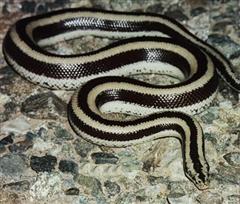Boa - Mexican Rosy
Scientific Name: Lichanura trivirgata trivirgata
Mon, 28th April, 2025 - 8:15 am GMT
Sponsor Ads:

Alternative Name
Scientific Name: Lichanura trivirgata trivirgataBasic Info
A relatively small and stout snake, the Mexican Rosy Boa typically will not grow to more than about 2.5 feet in length. Females tend to be longer and more heavy bodied than males. The small eyes of the Rosy Boa have vertical pupils, which are surrounded by small scales on the head. Males have two small spurs at the base of the tail. The Mexican Rosy Boa is characterized by broad, lengthwise dark brown or black stripes. These three stripes are usually on a creme to white background.
Health
Because, Rosy Boas are terrestrial, they do not need a tall enclosure. A minimum 20-gallon-long terrarium is a recommended for one or two adults. Some possible substrates include sand, aspen shavings, shredded newspaper. They should be provided with a hiding spot.The ambient temperature within the enclosure should be about 80 degrees Fahrenheit during the day,and they should have a basking spot between 85 and 90 degrees. At night the cage temperature should be about 70-75 degrees Fahrenheit. Keep enclosure humidity low. In captivity, Mexican Rosy Boas are primarily fed on small rodents. Juveniles should be fed about once a week, and adults can be fed every 7 to 10 days. Breeding To help insure successful breeding, Mexican Rosy Boas must first undergo a period of brumation. Prior to brumation, they should be fed more often than usual as they should not be fed while brumating or 2 weeks prior to being cooled. The temperature within the enclosure should be dropped to the low to mid 50 degrees Fahrenheit for a period of between six and ten weeks. In February, the enclosure should be gradually returned to its normal temperature. Feeding should be resumed about seven days later. The Mexican Rosy Boa will usually breed between three and eight weeks after brumation has ended. Male Rosy Boas will sometimes stop feeding during breeding. The female Mexican Rosy Boa will give birth to live young between 115 and 140 days after mating.Habitat
N/ABehavior
The Mexican Rosy Boa is a rather small snake that is generally calm and easy to handle and care for, making them an excellent pet snake. Mexican Rosy boas are mostly nocturnal, but are sometimes active at dusk and dawn. They are terrestrial, burrowing boas, but sometimes climb low-lying shrubs. Despite the arid air in the regions in which they are found, they are usually near where water is available.Origin
United States and MexicoHistory
The Mexican Rosy Boa can be found primarily in western Mexico and southern Baja, with a small population in southern Arizona.Common Foods
N/ASponsor Ads:
Against stupidity, the gods themselves contend in vain. -- Unknown
Boa - Mexican Rosy
Coded by: BGID® | ALL RIGHTS RESERVED Copyright © 2000-2025
Disclaimer | Privacy | Report Errors / Contact | Credits








 Preparing For China. China is growing their military. China Military Technology - can it keep up with the US?
Preparing For China. China is growing their military. China Military Technology - can it keep up with the US?  versus
versus 

 versus
versus 
 This Thread is about the North Korean Military itself - the kind of army, navy, and air force they have.
This Thread is about the North Korean Military itself - the kind of army, navy, and air force they have. 
 versus
versus 
 versus
versus  versus
versus